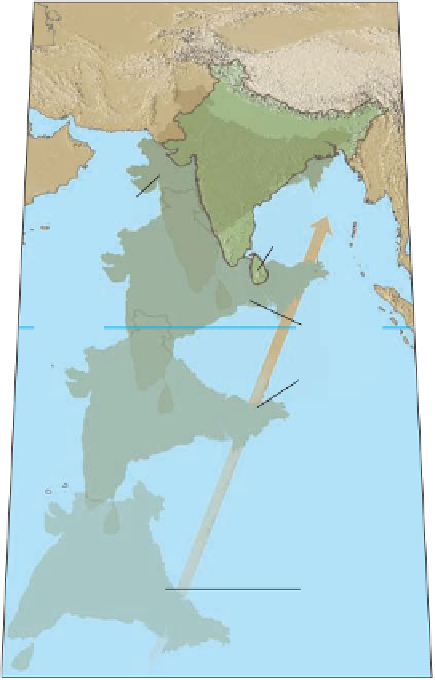Geology Reference
In-Depth Information
During its long journey north, India moved 15 to 20 cm per year;
however, beginning 40 to 50 million years ago, its rate of movement
decreased markedly as it collided with the Eurasian plate.
a
Eurasian Plate
India
today
10 million
years ago
Sri Lanka
Equator
38 million
years ago
55 million
years ago
INDIAN OCEAN
“India”
landmass
71 million
years ago
Sri Lanka
Aerial view of the Himalaya Mountains in Tibet.
b
◗
Figure 10.22
Orogeny at a Continental-Continental Plate Boundary and the Origin of the Himalayas
of Asia
Positive
gravity
anomaly
Positive
gravity
anomaly
Excess mass
of mountains
Expected deflection
of plumb line
Observed deflection
of plumb line
Negative
gravity
anomaly
Negative
gravity
anomaly
Low-density crust
Low-density crust
Higher-density mantle
Higher-density mantle
Low-density
mountain root
a
A plumb line (a cord with a suspended weight) is normally
vertical, pointing to Earth's center of gravity. Near a mountain range,
the plumb line should be defl ected as shown if the mountains are
simply thicker, low-density material resting on denser material, and a
gravity survey across the mountains would indicate a positive gravity
anomaly.
b
The actual defl ection of the plumb line during the survey in India
was less than expected. It was explained by postulating that the
Himalayas have a low-density root. A gravity survey, in this case,
would show no anomaly because the mass of the mountains above
the surface is compensated for at depth by low-density material
displacing denser material.
◗
Figure 10.23
Gravity Anomalies
Some of you might realize that crust floating on the
mantle raises an apparent contradiction. In Chapter 8, we
said that the mantle is a solid because it transmits S-waves,
which do not move through a fluid. But according to the
principle of isostasy, the mantle behaves as a fluid. When
considered in terms of the brief time required for S-waves


















Search WWH ::

Custom Search